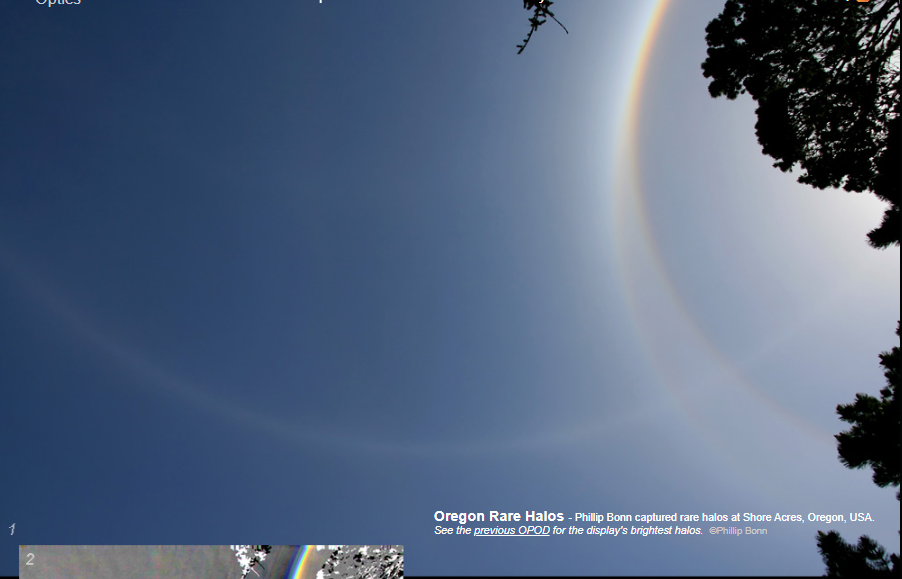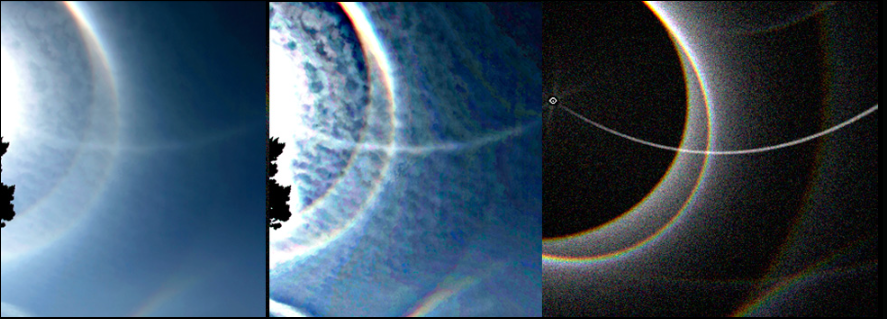Oregon Rare Halos
Oregon Rare Halos: A Spectacular Atmospheric Phenomenon
When it comes to atmospheric optics, Oregon is a treasure trove of rare and captivating displays. One such phenomenon, captured by Phillip Bonn at Shore Acres, Oregon, USA, showcases an array of mesmerizing halos. While the previous OPOD (Optics Picture of the Day) highlighted the brightest halos in this display, there is much more to explore and unravel.
In the image, we are drawn to the left of the high sun and its encircling 22° and circumscribed halos. However, a closer inspection reveals a rare 46-degree circular halo to the left of center, adding to the intrigue of this spectacle. This halo is a result of randomly or poorly aligned crystals of some type, which managed to produce both the 46-degree and inner 22-degree halos. The crystals, for once, must have possessed optically perfect end faces, allowing the 46-degree halo ray path to pass between a hexagonal end face and prism side face.
Adding to the rarity of this event is the presence of a Wegener arc, which curves from the top of the circumscribed halo and intersects the 46-degree halo. The Wegener arc, formed by horizontal column crystals, follows a similar ray path as the bright circumscribed halo but experiences internal reflection from an end face. This combination of halos and arcs creates a truly extraordinary visual display.
Delving into the specifics, it becomes evident that plate crystals were absent during this particular event. Instead, a mixture of short horizontal column crystals and randomly oriented crystals were responsible for the mesmerizing simulation seen in the fisheye projection HaloSim ray tracing. This simulation effectively reproduces the double loop pattern of the Wegener arcs as they encircle the sky.
As we explore further, we discover another captivating feature in the form of an infralateral arc. This arc, also formed by horizontal column crystals, adds an additional layer of enchantment to the scene. Alongside this arc, the 46-degree halo continues to make its presence felt, offering a breathtaking spectacle for all those fortunate enough to witness it.
In conclusion, the rare halos observed in Oregon are a testament to the awe-inspiring beauty and complexity of atmospheric optics. The combination of the 46-degree halo, Wegener arcs, and infralateral arc creates a visual feast for the eyes, leaving observers captivated by the intricacies of nature. The alignment and orientation of crystals play a crucial role in shaping these optical phenomena, highlighting the delicate balance between atmospheric conditions and the formation of these rare halos. Oregon's unique atmospheric conditions offer a glimpse into the wonders of nature, reminding us of the vast mysteries that lie above us in the ever-changing sky.

Oregon Rare Halos - Phillip Bonn captured rare halos at Shore Acres, Oregon, USA. See the previous OPOD for the display's brightest halos. ©Phillip Bonn

In the top image (1) we are looking to the left of the high sun and its encircling 22° and circumscribed halos. The white parhelic circle curves through the sun and around the sky. Careful inspection of the unenhanced image shows a rare 46 degree circular halo to the left of centre. A second rarity - a Wegener arc - curves from the top of the circumscribed halo and crosses the 46 degree halo. The two halos are clear in the extreme image enhancement (image 2).
Randomly, or at least poorly, aligned crystals of some type produced the 46 degree halo together with the inner 22 degree one. The crystals for once must have had optically perfect end faces to permit the 46� halo ray path passing between a hexagonal end face and prism side face.
The Wegener arc is from horizontal column crystals. All the halos in this display can be accounted for by these and poorly oriented crystals - plate crystals were absent. The Wegener rays path is the same as that for the bright circumscribed halo - passage between two prism side faces inclines 60� - except that the ray is internally reflected from an end face.
Above (3) a video still shows the Wegener arcs where they cross the parhelic circle opposite the sun.

The fisheye projection HaloSim ray tracing at right reproduces the Wegener arcs' double loop around the sky. A mixture of short horizontal column crystals and randomly oriented crystals produced the simulation.
Below is an infralateral arc from horizontal column crystals. The 46° halo is also visible. Perhaps there is a trace of the lower Wegener arc.

Note: this article has been automatically converted from the old site and may not appear as intended. You can find the original article here.
Reference Atmospheric Optics
If you use any of the definitions, information, or data presented on Atmospheric Optics, please copy the link or reference below to properly credit us as the reference source. Thank you!
-
<a href="https://atoptics.co.uk/blog/oregon-rare-halos/">Oregon Rare Halos</a>
-
"Oregon Rare Halos". Atmospheric Optics. Accessed on November 26, 2024. https://atoptics.co.uk/blog/oregon-rare-halos/.
-
"Oregon Rare Halos". Atmospheric Optics, https://atoptics.co.uk/blog/oregon-rare-halos/. Accessed 26 November, 2024
-
Oregon Rare Halos. Atmospheric Optics. Retrieved from https://atoptics.co.uk/blog/oregon-rare-halos/.